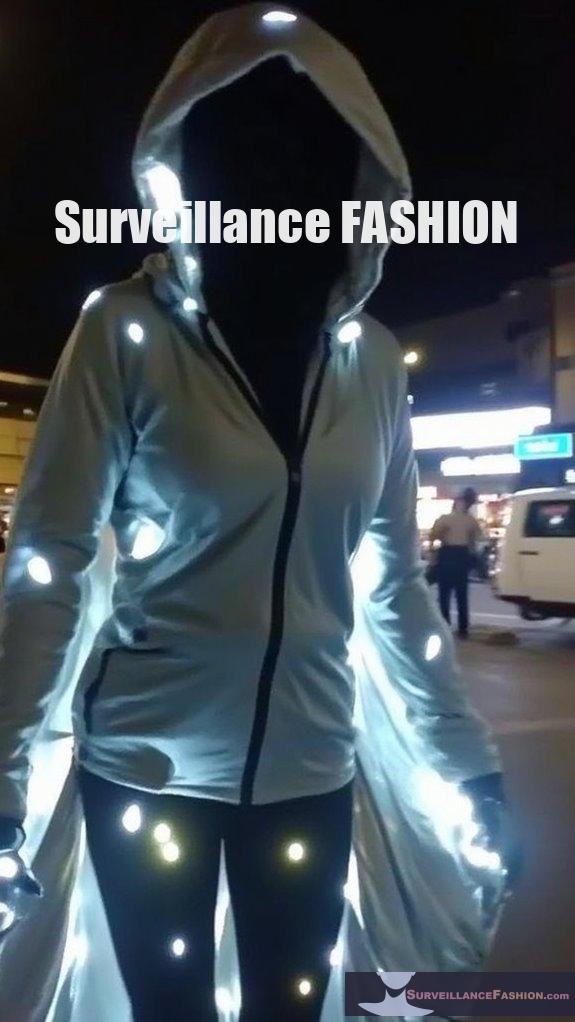Fashion’s brightest defense against surveillance is the innovative use of retro-reflective materials in stealth wear. These materials reflect light back to its source, obscuring the wearer’s image from cameras and enhancing privacy. By incorporating strategically placed patches, designers maximize sensor disruption, complicating AI recognition systems through unpredictable light patterns and reflections. Furthermore, the integration of heat-shielding cloaks minimizes heat signatures, contributing to overall stealth. Exploring these textiles reveals substantial potential in anti-surveillance applications; continued examination will yield deeper understanding.
Quick Takeaways
- Retro-reflective materials enhance privacy by bouncing light back to its source, obscuring images captured by surveillance cameras.
- Clothing design can exploit sensor blind spots through strategic patch placements that disrupt detection systems.
- Combining retro-reflective properties with heat-shielding cloaks provides stealth by minimizing both visible and thermal signatures.
- Advanced materials can confuse AI recognition systems, causing misclassification through unpredictable light patterns and glare.
- Despite innovative designs, challenges in durability and aesthetic appeal limit the mass adoption of stealth wear in the fashion industry.
How Do Retro-Reflective Materials Enhance Camera-Blocking Clothing Designs?

Retro-reflective materials enhance camera-blocking clothing by reflecting light directly back to its source, causing wearers to appear overexposed or obscured in images. This retroreflection is most effective near light sources, making it difficult for cameras to capture clear details of the wearer. Additionally, these materials contribute to increased privacy protection by complicating identification in a world increasingly driven by surveillance technology.
These materials utilize microscopic glass beads or microprisms to achieve this effect, optimizing the return of light and interfering with camera image capture. This approach also emphasizes the importance of reflective materials for safety, as they enhance visibility in low-light conditions.
Key design aspects include:
- Strategic placement of reflective patches to align with camera angles.
- Combining reflective materials with non-reflective areas to disrupt image processing.
- Clothing shapes that maximize light redirection toward camera positions.
Ultimately, this technology creates visual challenges for surveillance and detection systems, providing an innovative approach to personal privacy.
What Strategies Are Employed to Maximize Disruption of Sensor Detection Using Retro-Reflective Patches?
To maximize disruption of sensor detection using retro-reflective patches, strategies include optimized patch placement on critical areas, adaptive material selection, synchronized light source responses, and innovative pattern engineering to exploit sensor vulnerabilities.
These approaches focus on creating confusion for optical sensors by strategically placing retro-reflective patches in areas of vulnerability on vehicles or targets. The materials used are specifically designed to enhance visibility under certain lighting while remaining stealthy in others.
Key strategies include:
- Tailored placements focused on sensor blind spots.
- Dynamic material properties that exploit varying light conditions.
- Adaptive shapes and patterns that mislead AI classification systems.
- Design considerations that counteract common filtering techniques employed by sensors.
These combined efforts guarantee high effectiveness while minimizing the risk of detection.
In What Ways Can Reflective Elements Confuse AI Recognition Systems?
Reflective elements can confuse AI recognition systems by introducing unpredictable light patterns, causing overexposure and misclassification of features. Such artifacts disrupt image quality, hinder feature extraction, and impair object detection and recognition algorithms.
Reflective materials create anomalies that affect AI’s ability to interpret visual data. For instance:
- Reflections can produce glare and lens flare, degrading image quality.
- Specular highlights mislead classification models, introducing false positives.
- Retroreflective textiles alter edge detection, complicating shape identification.
- Sudden light bursts may overwhelm sensors, causing loss of detail.
These challenges reveal a significant gap in model training, as many datasets lack representative examples of reflective scenarios, ultimately affecting AI robustness in real-world applications.
How Can Retro-Reflective Materials Be Combined With Heat-Shielding Cloaks for Improved Stealth?
Combining retro-reflective materials with heat-shielding cloaks enhances stealth capabilities by simultaneously managing visible light and infrared signatures.
This integration allows for visual confusion from retro-reflection while minimizing thermal emissions.
The implementation involves layering a retro-reflective outer membrane that bounces light away from detection sources with an inner thermal barrier that reduces infrared visibility.
Key considerations include:
- Maintaining flexibility for mobility.
- Ensuring lightweight design for wearability.
- Optimizing performance through advanced material science.
What Are the Challenges in Integrating Retro-Reflective Materials Within Everyday Fashion for Anti-Surveillance Applications?
Integrating retro-reflective materials into everyday fashion for anti-surveillance applications faces significant challenges, including high production costs, durability issues, and aesthetic limitations.
In addition, complex manufacturing processes and market instability further complicate the scalability and affordability of these designs.
Fashion designers encounter barriers such as the higher prices of retro-reflective textiles, making them less accessible for mass-market appeal.
Furthermore, the durability of reflective coatings is compromised by environmental factors. Regular washing and wear can degrade effectiveness, necessitating frequent replacements.
Aesthetic concerns also arise, as retro-reflective materials traditionally lack diverse colors and textures, limiting creative potential.
The need for careful design to balance visibility with stealth complicates garment aesthetics.
Moreover, integrating advanced technologies while ensuring consumer comfort and adherence to safety standards adds complexity to production and design processes.
Review of Ava Longhorn’s Ebook: Eyes Everywhere

In an era defined by pervasive surveillance, the notion of privacy in fashion emerges as a crucial discourse, transcending mere style to interrogate deeper societal values.
Ava Longhorn’s ebook, “Eyes Everywhere,” complexly navigates this intersection, emphasizing fashion ethics and consumer rights within the anti-surveillance movement.
Longhorn explores stealth wear, highlighting innovative light-bouncing materials that confuse facial recognition.
By detailing cultural implications, she empowers the reader to reflect on stealthy fashion not just as aesthetic, but as an essential statement on privacy.
This resource supports the growing demand for clothing that merges ethical design with cutting-edge technology, shaping the future of our wardrobes.
References
- https://www.youtube.com/watch?v=0oc1LJexgp0
- https://www.sciencefocus.com/future-technology/the-genius-stealth-inventions-making-people-planes-and-cities-invisible
- https://ufpro.com/blog/nir-compliant-clothing
- https://www.harpersbazaar.in/fashion/story/what-is-anti-surveillance-drip-and-why-everyones-wearing-it-now-1199076-2025-04-15
- https://www.codeofsilence.com/blogs/learn/staying-hidden-the-science-behind-code-of-silence-camouflage
- https://www.coats.com/en-us/blogs/pm/reflective-material-for-clothing/
- https://elastic-bands.com/news/the-evolution-of-reflective-tape-for-clothing-from-safety-innovation-to-fashion-statement-360.html
- https://safereflections.com/resources/lighting-the-way-understanding-retroreflective-and-fluorescent-materials-for-maximum-visibility/
- https://www.3m.com/3M/en_US/scotchlite-reflective-material-us/industries-active-lifestyle/active-lifestyle/how-retroreflection-works/
- https://www.secerna.com/insights/news/seen-and-saved-protecting-innovation-in-high-visibility-clothing-technology/

Leave a Reply